These AP 10th Class Social Studies Important Questions 8th Lesson People and Migration will help students prepare well for the exams.
AP State Syllabus 10th Class Social 8th Lesson Important Questions and Answers People and Migration
10th Class Social 8th Lesson People and Migration 1 Mark Important Questions and Answers
Question 1.
What are Kopis?
Answer:
Kopis are conical huts made of bamboo mats and poles.
![]()
Question 2.
Write any one reason for international migration.
Answer:
Education and Employment are the main reasons for international migration.
Observe the graph below and answer questions 3, 4.

Question 3.
Which social background people are migrating more?
Answer:
OBC are migrating more.
Question 4.
What is the reason for short term migration?
Answer:
The reason for short term migration in rural areas is distress caused there.
Question 5.
Draw a rough pie chart to represent the information given in the table.
Population Expansion in Urban Regions 2001 – 2011
| Causes | % |
| Natural Increases | 44% |
| Expansion of Urban Area | 32% |
| Migration | 24% |
Answer:

Question 6.
How does migration arise?
Answer:
Migration arises out of various social, economic or political reasons.
![]()
Question 7.
How can we identify a person as a migrant?
Answer:
For identifying a person as a migrant, two criteria are used by the centres :
- birthplace
- last usual place of residence.
Question 8.
What is the most common reason for male migration?
Answer:
Employment or seeking employment is the most common reason for male migration.
Question 9.
Give some other reasons for migration.
Answer:
Dissatisfaction with employment opportunities for studies, loss in business, family, friends, etc. are also some other reasons for migration.
Question 10.
Where do the urban migrants have to work?
Answer:
Most urban migrants have to work in the unorganised sector. They could be working as hawkers, painters, repair persons, rickshaw pullers, construction labour, etc.
Question 11.
Which has been recognised as a natural response?
Answer:
For some people from rural areas moving to cities and towns to work in industry and other service activities have been recognised as a natural response to increase their in¬come and for better family prospects.
Question 12.
Why do migrants continue to live as daily workers?
Answer:
The migrants from rural to urban are not able to find jobs in the organised sector and therefore there’s no job security and decent income that they were aspiring for. They continue to live as daily workers.
Question 13.
Why is the number of seasonal migrants underestimated in India?
Answer:
The number of seasonal migrants is underestimated in India due to limitations in the definition of the term ‘migrant’ used in national surveys.
![]()
Question 14.
What is the Emigration Act, 1983?
Answer:
The Emigration Act, 1983 is the Indian law governing migration and employment of Indians abroad.
Question 15.
What are living areas of the sugarcane cutters?
Answer:
The Kopis are cramped together and bullocks are parked in front. Animals and humans live together in congested conditions.
Question 16.
Who are the rural seasonal migrants?
Answer:
The rural seasonal migrants are mainly agricultural labourers or marginal farmers in their place of origin and mostly belong to low-income households, dalits and Adivasis.
Question 17.
Where do rural seasonal migrants work?
Answer:
The rural seasonal migrants work in agriculture and plantations, brick kilns, quarries, construction sites and fish processing.
Question 18.
Who have a long history of migrating?
Answer:
Male from Saora tribals have a long history of migrating to work in Assam plantation, Munda and Santhal men migrate to work in mining sites in Odisha.
Question 19.
Which depend on migrant workers?
Answer:
Construction sites in most urban areas depend on migrant workers.
![]()
Question 20.
“It is also common to see migrants”
What is it?
Answer:
It is also common to see migrants selling plastic goods, vegetables, and engage in their petty businesses and casual labour.
Question 21.
What is the economic condition of the seasonal migrants?
Answer:
Seasonal migrants are not only poor but have little or no land at their native place.
Question 22.
What did the N.C.R.L. find?
Answer:
The National Commission of Rural Labour in its reports in 1990s found that uneven development and regional disparity triggered and accelerated seasonal migration.
Question 23.
How do the migrant labourers spend?
Answer:
Migrant labourers spend more on food as they cannot get food grains from fair price shops at their workplaces.
Question 24.
Why do they suffer from health problems?
Answer:
As they live in harsh circumstances and in unhygienic conditions, they suffer from health problems and are prone to diseases.
Question 25.
Name some health problems from which they suffer.
Answer:
Bodyache, sunstroke, skin irritation and lung diseases.
Question 26.
Why are migrants not able to access various health and family care programmes?
Answer:
Migrants are not able to access various health and family care programmes as they do not belong to the organised sector.
![]()
Question 27.
Do the migrant workers have maternity leave?
Answer:
No, they do not have maternity leave.
Question 28.
Which leaves a deep impact on migrants?
Answer:
Exposure to a different environment, stress associated with it, food available and social atmosphere leave a deep impact on migrants.
Question 29.
What does migration allow?
Answer:
Migration allows households to meet debt and other obligations without having to sell assets. It is also common to find migrant families buying house, land, agricultural machinery and consumer durables.
Question 30.
How do some migrants migrate regularly?
Answer:
Some migrants might take up jobs in the destination, acquire skills required in the destination area, become aware of how to get regular jobs and migrate regularly or permanently.
Question 31.
How many kinds of migrations are there? What are they?
Answer:
There are two kinds of migrations.
They are:
- Internal migrations
- International migrations.
Question 32.
Where do the skilled Indians migrate?
Answer:
The skilled Indians migrate to the U.S.A., the U.K., Canada, Germany, Norway, Japan and Malaysia.
![]()
Question 33.
What is the second type of international migration?
Answer:
The second type of international migration is unskilled and semi-skilled workers migrating to oil-exporting countries of West Asia on temporary contracts.
10th Class Social 8th Lesson People and Migration 2 Marks Important Questions and Answers
Question 1.
Read the following paragraph and answer the following question.
When males leave their families, this is also a major challenge for women who have to take care of all the responsibilities of the family and elderly people who need care. Young girls in such families are required to take care of siblings and many of them become dropouts.
What is the effect on girls if the head of the family migrates?
Answer:
When the head of the family migrates, the burden of the family falls on the woman. She has to work, earn and lead the family. As she works outside of the house, the girl children should take care of the younger children and elder people in the home, So they are becoming dropouts.
Question 2.
What do you suggest to overcome the problems of foreign migrants?
Answer:
- The government should take care of their security i.e., the embassies.
- They should not believe on unauthorized intermediators.
- Legal documents should be verified properly.
Question 3.
Do you think migrants are trouble makers? Justify your answer.
Answer:
- Yes. I think migrants are trouble makers.
- The migrants may not be provided with proper facilities by the government.
- The migrants may question for proper facilities in the long course.
- If the migrants begin to fight for their identity, then the trouble will start.
Ex: Tamil people in Sri Lanka.
(OR)
- No. I think migrants are not trouble makers.
- Generally migrants go for their livelihood.
- Therefore no scope to fight for domination.
- Migrants won’t trouble anybody because they won’t fight for identity and domination.
Ex: Sugarcane cutters in Maharashtra.
![]()
Question 4.
What are the problems faced by migrant labourers from villages to cities?
Answer:
- They have to face the problem for proper shelter and settlement.
- They may require references for jobs.
- As they have to work in the unorganised sector, they would have neither job security nor any incentives.
- They have to spend more on food.
Question 5.
Read the following paragraph and answer the question.
People migrate from rural areas mainly due to insufficient employment opportunities and the inadequate income available in rural employment. People also migrate with the expectation of higher incomes.
In urban areas, what are the common sectors of the economy in which migrants from the rural areas find employment? Give examples.
Answer:
In urban areas the unorganised sector is the common sector of the economy in which migrants from the rural areas find employment.
Question 6.
List out the reasons why the people have been migrating from your area.
Answer:
The following are the reasons for the people migrating from my area :
- Marriage is one of the most common reasons for female migration.
- Employment or seeking employment is another reason for males to migrate.
- Dissatisfaction with employment opportunities in the native place, better opportunity for studies, loss in business, family feuds etc. is the other causes for migrating.
Question 7.
What are the reasons for migration?
Answer:
- Migrations can happen due to many reasons.
- Females reported marriage as the most common reason.
- Males migrate on employment or seeking employment opportunities.
- Dissatisfaction with employment opportunities in the native place is one reason.
- Better opportunity for studies, loss in business, family feuds are some other reasons for migration.
Question 8.
Create a pamphlet on “Prevention of Migration”.
Answer:
PREVENTION OF MIGRATION
Reasons: When families migrate, they live in harsh circumstances and in unhygienic conditions, they suffer from health problems and are prone to diseases.
Migratory pressures on communities of origin can be related social and economic distress. They can be linked to environmental degradation as well as natural man made hazards and they can be due persecution on conflict and violence. By supporting disaster preparedness and building resilence at the community level.
Conclusion: Why should we prevent means reduce the problems. National societies contributing to elevating pressures that can induce people to migrate against their will and desire.
![]()
Question 9.
How does the gender bias effect when the women work outside of the home nowadays?
Answer:
Before the rise of large scale industrialization, home and workplace were one and the same. But now the disparity between men and women in the workplaces is a common issue.
Workers acknowledge gender discrimination is possible in modem organizations, but at the same time maintain their workplaces to be gender-neutral.
Women are facing a high degree of gender bias when it comes to their career. There is a general perception that women are less capable than men in matters of business and decision making.
It is often a strenuous struggle for a woman not just to her mettle but also to make a deserving way to the top. Career goals of women are considered less important compared to male counterparts. The disparity is also seen in the wages and salaries also. Thus the relationship is negative.
Question 10.
Study the information given below and write your observations.
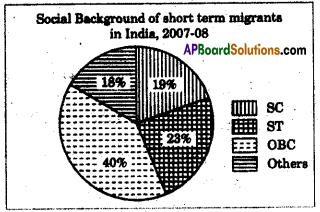 Answer:
Answer:
- The above pie diagram is about the social background of short term migrants.
- OBC and ST account for 40% and 23% of the migrants respectively.
- Most of the OBC are skilled in making some items.
- So they produce the articles and migrate to cities to sell their products.
- SC people are benefited by the schemes provided by the government and their share is less.
![]()
Question 11.
‘Most children of migrant families become drop-outs.’ Do you agree with this statement? Justify your answer.
Answer:
- Yes, I agree that children become dropout if the parents are migrants.
- When families migrate, children also accompany their parents.
- They cannot get admission in schools in their parents workplace without transfer certificate.
- Schools in their native place refuse to take them when they come back.
- When parents migrate, the elder child especially the girl child, has to take care of the younger siblings.
- Due to the above reasons, the children become dropouts.
Question 12.
Why are Embassies set up?
Answer:
Embassies set up by the Indian Government in different countries are expected to follow the legal procedures and protect the welfare of the international migrants as given in the Emigration Act.
Question 13.
Which depends upon the needs of rural family members?
Answer:
Remittances – money sent by migrants from their destination – are an important means of supplementing, or generating additional incomes for the rural family. The amount of remittances and the pressure to remain in the urban areas depends upon the needs of rural family members.
Question 14.
Why do migrants retain the economic ties in rural areas?
Answer:
Migrants retain the economic ties in rural areas because they want to safeguard their rights over land and homestead. Families left in rural areas are important for most urban migrants. In feet, it is the family which decides whether their family member should migrate or not.
Question 15.
Write about Sugar belt.
Answer:
The seven districts in western Maharashtra- Nasik, Ahmadnagar, Pune, Satara, Sangli, Kolhapur and Sholapur – comprise the”sugar belt” which extends into Surat(Gujarat) in the north and Belgaum(Karnataka) in the south. Five districts of the arid Marathwada region – Beed, Jalgaon, Ahmadnagar, Nasik and Jalna – send out labour to this sugar belt for six months every year for sugarcane harvesting.
![]()
Question 16.
Why do people migrate from rural areas?
Answer:
People migrate from rural areas mainly due to insufficient employment opportunities, inadequate income available in rural employment. They also migrate with the expectation of higher incomes and more opportunities for family members and may be better services.
Question 17.
Why do many families have residences at both the ends?
Answer:
Many families have residences both at their origin- (native place) and at the destination. They shift between the two depending on work and seasons. The migration does not necessarily involve the movement of all members of the family, and often the wife remains in the rural area.
Question 18.
Why do migrants also pass on the urban opportunities to the rural areas?
Answer:
Migrants also pass on the urban opportunities to the rural areas so that potential migrants can engage in the rural-based job search. In most cases, migration is a survival strategy for many families.
Question 19.
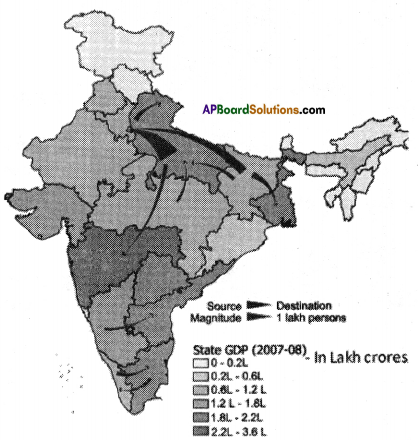
Estimate the rural to urban migration from Bihar to Lucknow, Kolkata and Delhi.
Answer:
- Rural to urban migration from Bihar to Lucknow = 2 lakhs
- Rural to urban migration from Bihar to Kolkata = 2 lakhs
- Rural to urban migration from Bihar to Delhi = 6 lakhs
![]()
Question 20.
From which states in migrations are high? Give reasons.
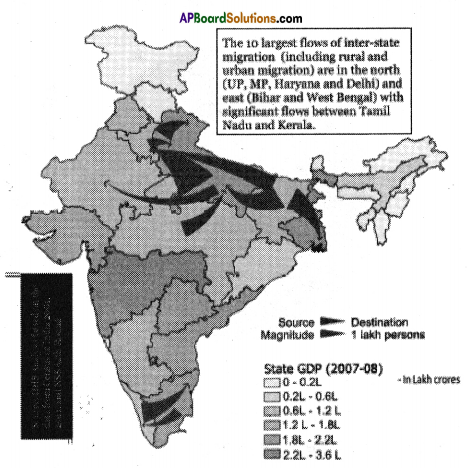 Answer:
Answer:
Migrations are high from states of Uttar Pradesh, Bihar and Kerala. Western Uttar Pradesh and Delhi are industrially developed.
Question 21.
Read the above graph and answer the following questions.
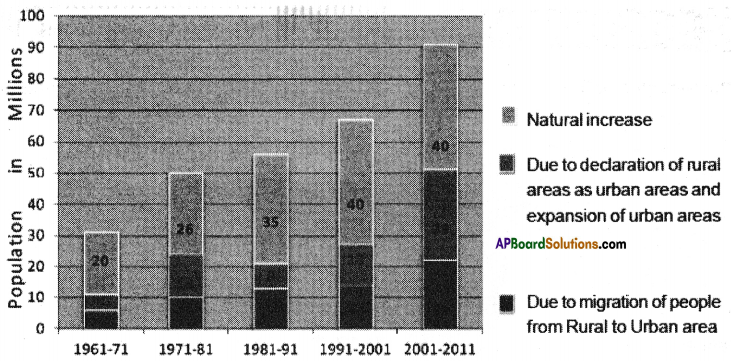
- In the Decade of 1961-71 the urban population of India is ………..
Answer:
The urban population of India in 1961 – 71 is 31 million. - At the end of 2001-11 decade the urban population is ………..
Answer:
The urban population of India in 2001 -11 is 91 mn. - How many times did the urban population increase from 1961-71 decade to 2001-11 decade?
Answer:
The urban population increased from 1961 – 71 to 2001 -11 is by 3 times.
Question 22.
Graph: Social Background of short term migrants in India, 2007-08
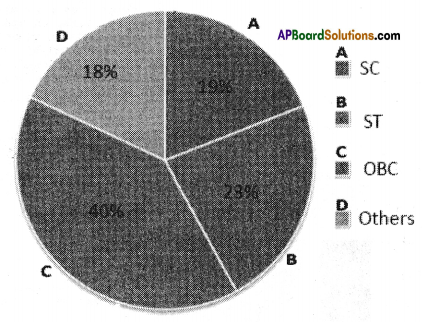
Read the given Pie diagram and answer the following questions.
- How much per cent of STis migrated in 2007-08?
Answer:
ST’s constitute 23% of the migrated in 2007 – 08. - Which is the maximum migrated class In 2007-08? what is its percentage?
Answer:
The maximum migration is from the class of OBCs and it is 40%. - In which class we notice minimum migrants?
Answer:
The minimum migrants are there from others which is 18%.
10th Class Social 8th Lesson People and Migration 4 Marks Important Questions and Answers
Question 1.
What is the meaning of international migration? Identify the reasons and consequences of it.
Answer:
Migration of the people from one country to another country due to various reasons is called “international migration”.
Reasons:
- For higher education
- For better employment opportunities
- For business needs Consequences:
- Financial conditions of the migrant families improve.
- They are able to pay back loans and buy assets.
- Changes occur in their lifestyle.
- Brain drain has become a major hazard to the progress of the country’s economy.
![]()
Question 2.
When families migrate, children accompanying their parents do not have creche facilities. Grown-up children are not able to continue their studies at their parents’ new workplaces. Schools in their native place refuse to take them again when they come back. They finally become dropouts. When males leave their families this is also a major challenge for women who have to take care of all the responsibilities of the family and elderly people who need care. Young girls in such families are required to take care of siblings and many of them become dropouts.
“Most of the children of migrant families become dropouts” – Comment.
Answer:
- Yes, it is true. When families migrate most of the children of migrant families become dropouts.
- At the place of migration, creche facilities are not available for the children.
- Even if there are such facilities poor families cannot afford them.
- Sometimes even schools are not available at migrant places.
- Schools in their native places refuse to take them again when they come back.
- This is damaging their interest in studies.
- Young girls in migrant families often required to take care of their siblings.
- Now – a – days government schools are admitting such students.
- But even then, they are lagging behind in their studies.
- Special training should be given to them during the holidays.
Question 3.
Write your reflections on the vulnerable conditions of Indian migrants to West Asia.
Answer:
Vulnerable conditions of Indian migrants to West Asia :
- At times, migrant workers are not paid their salaries, recruitment agents cheat prospective workers or collect more than the prescribed fees for their role in getting work for workers abroad.
- Employers also terminate the job contract before its expiry, change the employment contract to the disadvantage of migrant workers.
- Pay less than the agreed salary and freeze fringe benefits and other perks.
- They often force workers to do overtime without making additional payments and deny permission to keep one’s own passport.
- Indian migrant workers seldom lodge any complaint against their foreign employers for the fear of losing their jobs.
Question 4.
Observe the given pie chart and answer the question that follows:
 Write a paragraph analyzing it.
Write a paragraph analyzing it.
Answer:
This pie chart is about the social background of short term migrants in India, 2007-08. It gives category wise information of SC, ST, OBC and Others. On the overall observation, it is clearly understood that major number is from OBCs and others are less in percentage.
Normally in population, the number of people from other backward classes is more. It is also observed in rural areas. People belong to scheduled castes and scheduled tribes have very less land and in some cases they have no lands. Recently the trend is changing. Due to some welfare schemes, they are also leading a better life. The percentage of others is also nearly equal to the scheduled castes. Their migration purpose may be different. Many of these migrants work in unorganized sector like, construction work, brick industries, selling plastic goods and vegetables or in casual work.
The government should take care of these migrants and think why these people are migrating from their places. If possible rural prosperity is to be focused. Public facilities are to be provided at the rural areas and so this migration can be stopped or decreased.
Question 5.
Read the given paragraph and interpret.
Labour being the most abundant factor of production, it would be ideal if the new ways of farming used much more labour. Unfortunately, such a thing has not happened. The use of labour on farms is limited. The labour, looking for opportunities is thus migrating to neighbouring villages, towns and cities. Some labour has entered the nonfarm sector in the village.
Answer:
- Labour means people who do the work either highly trained and educated or who can do manual work.
- Each worker is providing necessary labour for production.
- Skilled or semi-skilled or unskilled labour – all are providing labour for production.
- Thus labour is an essential item in production.
Conclusion : If government provide loans to landless labour for Agriculture purpose, motor pump sets, engines, etc. more labour we will find in agricultural sector.
![]()
Question 6.
Write down the advantages and disadvantages of the people when they migrate.
Answer:
- Urban migrants have plenty of opportunities for education and acquire new skills and take us new jobs effectively.
- Thus they earn more incomes.
- Remittances are an important means of supplementing or generating additional income for rural families.
- Migration allows households to meet debt and other obligations without having to sell assets.
- Migrant families buy house, land, gold, agricultural machinery and consumer durables.
- Majority of migrants either remit or bring back savings.
- Thus their purchasing power increases.
Disadvantages:
- Migrant labourers spend more on food as they cannot get food grains from fair prices shops.
- They live in harsh circumstances and in unhygienic conditions.
- They suffer from health problems and are prone to disease.
- They do not have creche facilities.
- Grown up children are not able to continue their studies at their parent’s new workplaces.
- Exposure to different environment, stress associated with it, food available and social atmo¬sphere leave a deep impact on migrants.
Question 7.
Observe the information given in the table and analyse.
Table: Migrations in India [Census 1991-2001]
| Migration by place of birth | Census 1991 (excluding J & K in millions) | Census 2001 (including J & K in millions) | Variation (%) 1991-2001 |
| Total population | 838.5 | 1028.6 | 21.5 |
| Total migrations | 229.8 | 307.1 | 32.9 |
| Migrants from within the districts | 136.2 | 181.7 | 32.6 |
| Migrants from other districts of state | 59.1 | 76.8 | 29.5 |
| Migrants from other states in India | 27.2 | 42.3 | 54.5 |
| Migrants from other countries | 6.9 | 6.1 | (-) 11.6 |
Answer:
Table Analysis:
According to 1991 & 2001 census,
- The total population in 1991 was 838.5 million excluding J & K. At the same time in 2001 it was 1028.6 million including J&K. There was a variation of 21.5% growth in the population.
- Total migrated people in 1991 were 229.8 million and they were in 2001, 307.1 million. There was 32.9% variation from 1991 to 2001.
- Migrants from within the districts in 1991 were 136.2 million and in 2001 were 181.7 million. The variation is 32.6%.
- Migrants from other districts of the state in 1991 were only 59.1 million and in 2001 were 76.8 million. The variation is 29.5%.
- In 1991 migrants from other states in India were 27.2 million and in 2001 they were 42.3 million. The variation is 54.5%.
- Migrants from other countries were 6.9 million in 1991. This number reduced to 6.1 million in 2001. Hence, the variation is (-) 11.6%.
From the above information, it is evident that the total migrations increased from 1991 to 2001. Migrants within the district and migrants from other districts of the state increased. Because of employment, facilities and education also increased.
Some areas are not developed, that’s why people are migrating from one place to other places.
Conclusion: Finally from the above information we understand that migrants from other countries to India decreased. So we understand that foreigners are not preferring to migrate India because of lack of resources and employment and low paid salaries.
![]()
Question 8.
Read the following paragraph and answer the following question.
The men drive the carts to the factory where they might have to wait in queue for several hours before they get to offload the cane. The women, meanwhile, walk several kilometres back to the settlement. They have to fight exhaustion all the time.
How far is the household work done by the women in these circumstances justified?
Answer:
- Both men and women work in the sugarcane fields.
- The cane piles are tied into bundles, carried on the head by men and women.
- Men drive the carts to the factories.
- After doing heavy work on cane fields, women walk several kilometres back to the settlement.
- Then they have to perform household work.
- They have to fight exhaustion all the time.
- But the wage paid to the women is less when compared to the men.
- Hence we can conclude this discrimination is not justified on any grounds.
People migrate from rural areas mainly due to insufficient employment opportunities and the inadequate income available in rural employment. People also migrate with the expectation of higher incomes and more opportunities for family members and may be better servicing. Ramaiah was able to find work in the organized sector. However, most urban migrants have to work as labourers and find employment in the unorganized sector. They could be working as hawkers, painters, repair persons, rickshaw pullers, construction labour, etc.
Question 9.
Read the following paragraph and write your opinion on it.
People migrate from rural areas mainly due to insufficient employment opportunities and the inadequate income available in rural employment. People also migrate with the expectation of higher incomes and more opportunities for family members and may be better services. Ramaiah was able to find work in the organized sector. However, most urban migrants have to work as labourers and find employment in the unorganized sector. They could be working as hawkers, painters, repair persons, rickshaw pullers, construction labour, etc.
Answer:
- According to the paragraph the people migrate to urban areas as there is no sufficient work in rural areas.
- They expect high income from urban areas but they settle in unorganized sector.
- They also have no job security and they face many problems.
- My opinion is that nowadays every individual want high income for their families.
- The people are ready to go anywhere for that.
- They are forcibly settling in the unorganized sector.
- Some of them don’t find even daily wages.
- In conclusion I suggest the government to take care of these labourers of the unorganized sector and launch new schemes for these migrants.
A large section of rural workers migrate for a short duration and particularly due to distress caused in rural areas. They are mainly agricultural labourers or marginal farmers in their place of origin and mostly belong to low Income households, dalits and adivasis.
![]()
Question 10.
Read the following paragraph and write your opinion on it.
Answer:
- As per the paragraph given, it is understood that most of the labourers migrating from rural areas to urban areas are from marginalized families.
- Their income is low and they are SCs and STs.
- They come to cities and towns in distress.
- My opinion is that most of the dalits and adivasis have no agricultural lands. They are agricul¬tural labourers working in others fields.
- When they find no work in some peculiar seasons they migrate to urban areas.
- Especially the adivasis are still leading their lives based on the forest produce.
- I suggest the government to take up new initiatives for the sake of these low-income groups. MNREGA programmes should be launched in needy areas.
Question 11.
Read the following paragraph and write your comments.
Construction sites in most urban areas depend on migrant workers. It is also common to see migrants selling plastic goods, vegetables, and engage in other petty businesses and casual labour. A large section of such migrants are from tribal communities and from drought-prone areas of the state. Seasonal migrants are not only poor but have little or no land at their native place.
Answer:
- The given paragraph says that different activities in urban areas depend on migrant workers.
- Drought is also one of the reasons for migration. Many of the migrants are from tribal communities. They have no lands and so they are very poor.
- My comments on this paragraph are that it is true the many of the migrants are working on construction sites and they are in the unorganized sector.
- They don’t find work on all the days.
- When there is a work they get wages. Many a time they spend their time waiting for work.
- I conclude by saying these unorganized sector people are to be identified.
- Special schemes are to be designed and launched. They should be provided with work but not simply financial help.
- Banks should provide loans without collateral and so they can survive for themselves.
Question 12.
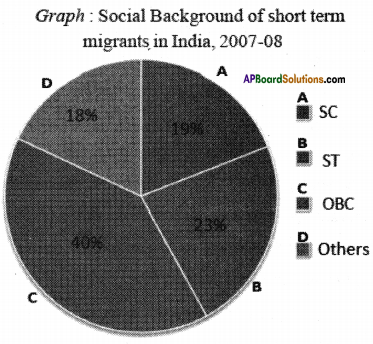
Prepare a paragraph on the above pie chart.
Answer:
- This pie chart is about the social background of short term migrants in India, 2007-08. It gives category wise information of SC, ST, OBC and Others.
- On the overall observation, it is clearly understood that major number is from OBCs and others are less in percentage.
- Normally In population, the number of people from other backward classes is more.
- It is also observed in rural areas.
- People belong to scheduled castes and scheduled tribes have very less land and in some cases, they have no lands.
- The government should take care of these migrants and think why these people are migrating from their places.
- If possible rural prosperity is to be focused.
- If Public facilities are to be provided at the rural areas and so this migration can be stopped or decreased.
![]()
Question 13.
Draw and locate the following.
- Draw the Andhra Pradesh map and locate Amaravathi.
- Draw the Andhra Pradesh map and locate Krishna, East & West Godavari districts.
Answer:
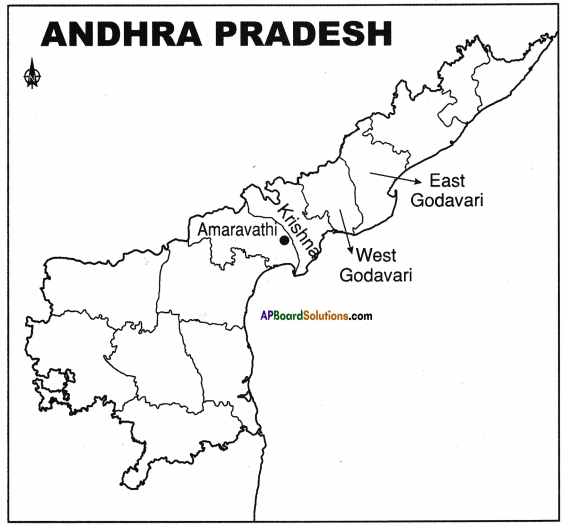
Question 14.
In the following map, estimate the urban migration to Delhi from UP and Bihar.
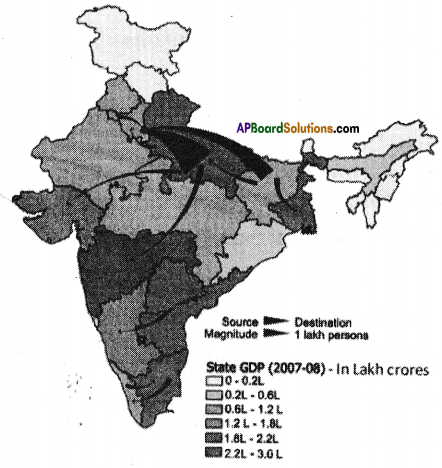
Answer:
- Approximately 2 lakh persons migrated from Bihar to Delhi.
- Approximately 4 lakh persons migrated from UP to Delhi.
Question 15.
In the following map, estimate the rural to urban migration from Karnataka to AP.
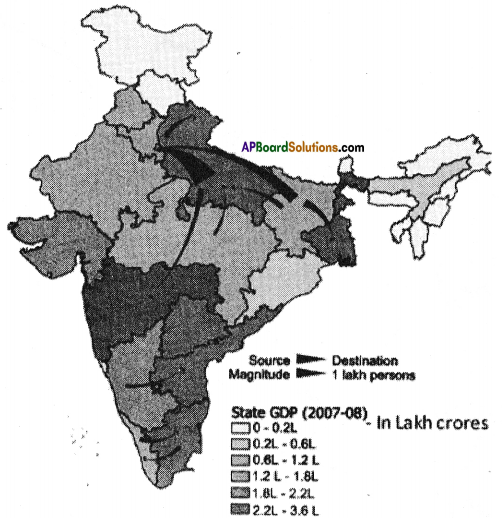
Answer:
Approximately 0.5 lakh persons migrated from Karnataka to AP.
![]()
